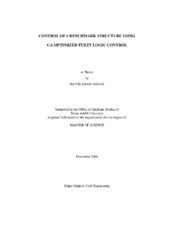Control of a benchmark structure using GA-optimized fuzzy logic control
| dc.contributor.advisor | Roschke, Paul N. | |
| dc.creator | Shook, David Adam | |
| dc.date.accessioned | 2010-01-15T00:02:06Z | |
| dc.date.accessioned | 2010-01-16T02:20:36Z | |
| dc.date.available | 2010-01-15T00:02:06Z | |
| dc.date.available | 2010-01-16T02:20:36Z | |
| dc.date.created | 2006-12 | |
| dc.date.issued | 2009-05-15 | |
| dc.identifier.uri | https://hdl.handle.net/1969.1/ETD-TAMU-1088 | |
| dc.description.abstract | Mitigation of displacement and acceleration responses of a three story benchmark structure excited by seismic motions is pursued in this study. Multiple 20-kN magnetorheological (MR) dampers are installed in the three-story benchmark structure and managed by a global fuzzy logic controller to provide smart damping forces to the benchmark structure. Two configurations of MR damper locations are considered to display multiple-input, single-output and multiple-input, multiple-output control capabilities. Characterization tests of each MR damper are performed in a laboratory to enable the formulation of fuzzy inference models. Prediction of MR damper forces by the fuzzy models shows sufficient agreement with experimental results. A controlled-elitist multi-objective genetic algorithm is utilized to optimize a set of fuzzy logic controllers with concurrent consideration to four structural response metrics. The genetic algorithm is able to identify optimal passive cases for MR damper operation, and then further improve their performance by intelligently modulating the command voltage for concurrent reductions of displacement and acceleration responses. An optimal controller is identified and validated through numerical simulation and fullscale experimentation. Numerical and experimental results show that performance of the controller algorithm is superior to optimal passive cases in 43% of investigated studies. Furthermore, the state-space model of the benchmark structure that is used in numerical simulations has been improved by a modified version of the same genetic algorithm used in development of fuzzy logic controllers. Experimental validation shows that the state-space model optimized by the genetic algorithm provides accurate prediction of response of the benchmark structure to base excitation. | en |
| dc.format.medium | electronic | en |
| dc.format.mimetype | application/pdf | |
| dc.language.iso | en_US | |
| dc.subject | structural control | en |
| dc.subject | fuzzy logic control | en |
| dc.subject | magnetorheological dampers | en |
| dc.subject | experimental testing | en |
| dc.subject | neuro-fuzzy modeling | en |
| dc.subject | system identification | en |
| dc.subject | acceleration feedback control | en |
| dc.subject | multiobjective genetic algorithm | en |
| dc.title | Control of a benchmark structure using GA-optimized fuzzy logic control | en |
| dc.type | Book | en |
| dc.type | Thesis | en |
| thesis.degree.department | Civil Engineering | en |
| thesis.degree.discipline | Civil Engineering | en |
| thesis.degree.grantor | Texas A&M University | en |
| thesis.degree.name | Master of Science | en |
| thesis.degree.level | Masters | en |
| dc.contributor.committeeMember | Butenko, Sergiy | |
| dc.contributor.committeeMember | Jones, Harry | |
| dc.type.genre | Electronic Thesis | en |
| dc.type.material | text | en |
| dc.format.digitalOrigin | born digital | en |
Files in this item
This item appears in the following Collection(s)
-
Electronic Theses, Dissertations, and Records of Study (2002– )
Texas A&M University Theses, Dissertations, and Records of Study (2002– )


